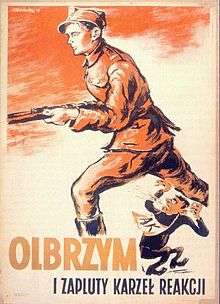Propaganda in the Polish People's Republic

Communist propaganda played an important role in the Polish People's Republic, one of the largest and most important communist satellite states of the Soviet Union. Together with the use of force and terror it was instrumental in keeping the communist government in power and was designed to shape Polish society into a communist one.[1]
The language of Communist propaganda was extremely violent. All those who disagreed with the voice of the Party were dubbed as "fascists" and "reactionary thugs". For example, towards the end of World War II already, political officers in the army received specific guidelines for the training of soldiers, ordering them to refer to all anti-Nazi resistance on Polish lands – other than communist – as the "bastards of the NSZ and AK," and "Hitler’s emulators".[2] The insurgents of anti-German uprisings became synonymous with "bandits," "traitors," "anti-Semites" and "Jew-killers." Since 1944, the propaganda campaigns were usually followed by jarring abuses of human rights and the application of torture in the communist legal system.[2]
In the 1970s Polish propaganda was dominated by the form known as propaganda of success.
See also
- Censorship in the Polish People's Republic
- Culture in the Polish People's Republic
- Education in the Polish People's Republic
- Polish underground press (bibuła)
- Eastern Bloc information dissemination
References
- ↑ Wojciech Roszkowski, Najnowsza historia Polski 1914-1945. Warszawa: Świat Książki, 2003, p. 236-240, 678-680, 700-701. ISBN 83-7311-991-4.
- 1 2 Marek Jan Chodakiewicz, "The Legal Basis of Torture and the Communist Propaganda", in The Dialectics of Pain: The Interrogation Methods of the Communist Secret Police in Poland, 1944-1955. Glaukopis, vol. 2/3 (2004-2005).
External links
- (Polish) Propaganda w PRL-u
- (Polish) Internetowe Muzeum Polski Ludowej
- (Polish) Komunizm, socjalizm i czasy PRL-u
- (Polish) Propaganda komunistyczna